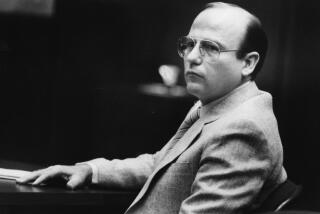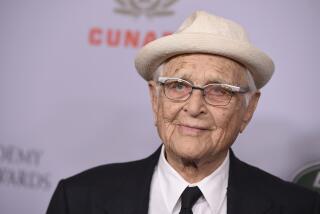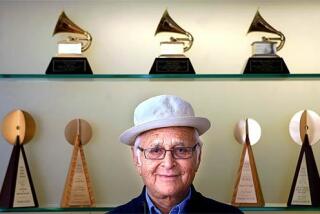Curtis LeMay, 83, Bomber General of WW II, Dies : Warrior: He later built the Strategic Air Command. He was George Wallace’s running mate in 1968.
Curtis Emerson LeMay, the tough bomber general who directed the smashing of German and Japanese cities during World War II and then built the Strategic Air Command into a powerful nuclear strike force, died Monday of a heart attack. He was 83.
The four-star general relayed President Harry S. Truman’s orders to drop nuclear bombs on Hiroshima and Nagasaki, ending the war, despite his later-expressed belief that Japan could have been defeated with conventional incendiary bombs.
LeMay died at 8:08 a.m. in the 22nd Strategic Hospital at March Air Force Base near Riverside, an Air Force spokesman said. He would have been 84 on Nov. 15.
LeMay had been living in Air Force Village West, a retirement community for Air Force officers near the air base.
He had remained in Southern California since he was fired from his post-military job as board chairman of a Chatsworth electronics firm for serving as the running mate of George C. Wallace in the 1968 presidential campaign.
To an adoring American public during the war against the Axis powers, LeMay was “Old Iron Pants” and usually described as “cigar-chomping,” “gruff” or “brusque.” He was a strict disciplinarian who asked much of his fliers, but no more than he asked of himself.
Deciding that his bombers were missing too many targets while zigzagging to avoid heavy flak over Europe, LeMay clamped a cigar in his jaw and personally led the next raid over Saint Nazaire, France, holding his plane on a straight-in course for seven perilous minutes. The next day he issued orders that there would be “no more evasive action on the final bombing run.”
His hero image began to fade somewhat during ensuing years as he continued to talk like a combat man, observing that most Americans had a “phobia” about nuclear weapons (“just another weapon in the arsenal”), and suggesting that North Vietnam be bombed “back into the Stone Age.”
Controversy surrounded him in the early 1960s when, as Air Force chief of staff, LeMay feuded with then-Secretary of Defense Robert McNamara over the latter’s push to cut back the number of manned aircraft in favor of more intercontinental ballistic missiles.
It intensified when LeMay saw fit to be Wallace’s running mate, attracting demonstrators who chanted “Bombs away with Curtis LeMay!” He caused some embarrassment for Wallace by saying he would use nuclear weapons “if I found it necessary,” a comment Wallace angrily contended was reported out of context.
Already known as a man of few words, LeMay grew even quieter in retirement. When he reluctantly attended an Orange County soiree in 1984, the old warrior said only, “I just stay at home and keep my mouth shut. That’s always the best thing to do.”
A pure military man, he did not go around in peacetime expressing regrets for his battle actions. “I have indeed bombed a number of specific targets,” he conceded in the foreword of the 1965 book “Mission With LeMay,” which he wrote with novelist and fellow World War II flier MacKinlay Kantor. “They were military targets on which the attack was, in my opinion, justified morally. I’ve tried to stay away from hospitals, prison camps, orphan asylums, nunneries and dog kennels. I have sought to slaughter as few civilians as possible.”
Off duty, LeMay was an enthusiastic ham radio operator, gun collector and big-game hunter.
He was known for backing his men when they made understandable mistakes, but he did not tolerate the same mistake twice.
Once, invited to dinner by a group of colonels serving under him, the crusty LeMay refused. “A man should have dinner with his friends,” he growled. “The commanding general has no friends.”
LeMay was born in Columbus, Ohio, on Nov. 15, 1906. He was the eldest of six children of itinerant ironworker Erving LeMay and Arizona Dove LeMay.
He was fascinated by airplanes from childhood. He recalled in his book seeing pioneer stunt aviator Lincoln Beachy flying around the 1915 Panama-Pacific Exposition in San Francisco. After Beachy crashed into San Francisco Bay and died, LeMay wrote, “I wondered a little where he had gone--but mostly I remembered how he felt when he was alive and flying.”
He ached to go to West Point, but did not get appointed by his congressman, so he enrolled at Ohio State University as an engineering student, joined the Reserve Officer Training Corps and paid his way through college working in a foundry and at other jobs. He had to work so much that he did not get his degree until after he was in the service.
He won a reserve Army commission through the ROTC, going on active duty with the 62nd Field Artillery Brigade at Camp Knox, Ky. He enlisted in the regular Army in 1928.
LeMay got into air cadet school at March Field (now March Air Force Base), and by 1930 was a second lieutenant in the regular Army Air Corps.
He served in bomber and pursuit squadrons, participating in a 1937 goodwill flight of B-17 Flying Fortresses to South America. He was a pioneer of over-water navigation and of ferry routes to Africa via South America.
Soon after World War II erupted, LeMay was a colonel in command of the 305th Bombardment Group. He took the group to England in the fall of 1942. As part of the 8th Air Force, it was one of the first U.S. air bombardment units to enter combat.
LeMay flew five combat missions over Europe, winning the Air Medal and the Silver Star. In addition to leading the raid over Saint Nazaire to establish his rule against zigzag bombing runs, “Old Iron Pants” also led the Aug. 17, 1943, shuttle mission of B-17s from England over Regensburg, Germany, and on to landings in North Africa, the first such mission flown.
For his heroism in leading that attack on Germany’s principal Messerschmitt plant at Regensburg, he was awarded the Distinguished Service Cross.
Promoted to brigadier general and then major general, LeMay was commander of the 3rd Bombardment Division through mid-1944, then was sent to the China-Burma-India Theater to head the 20th Bomber Command. Under him, China-based B-29 Superfortresses attacked Manchurian industrial centers.
Taking over the 21st Bomber Command in the Mariana Islands, LeMay ordered his bombers to fly at previously unheard-of low altitudes. He sent his full force of 300 B-29s on a nighttime incendiary raid on Tokyo. They flew at only 5,000 feet, below the effective range of Japanese antiaircraft batteries, and dropped 2,500 tons of firebomb clusters that set off a firestorm that burned out more than 256,000 buildings.
LeMay piloted a B-29 on a record-breaking flight from Guam to Washington, D.C., just before the war ended.
When the Air Force became an independent service in 1947, he was assigned to command U.S. forces in Europe, where he headed the 1948 Berlin Airlift to break the Soviet blockade. He flew several of the trips in and out of Berlin himself--usually unannounced--in order to straighten out problems.
In October, 1948, LeMay took over the Strategic Air Command, finding it to be made up of weary fliers left over from World War II. He set up headquarters in Omaha and built SAC into a proud, energetic outfit that kept nuclear-armed intercontinental bombers in the air around the world at all hours of the day and night. Aerial refueling was perfected.
SAC went from 600 bombers and smaller planes at 18 bases to a force of 3,000 hydrogen-bomb-carrying jets at more than 50 bases worldwide. LeMay saw to it that his men lived comfortably, and that there were plenty of hobby shops and other leisure facilities to keep them from getting bored.
In 1957, after heading SAC for eight years, LeMay became vice chief of staff for the Air Force. Months later, he set a record flying a giant jet tanker nonstop from Buenos Aires to Washington. The following year, he broke another record piloting a jet tanker from Tokyo to Washington.
In 1961, President John F. Kennedy named him Air Force chief of staff, even though LeMay had already raised hackles by criticizing the Air National Guard as inefficient. Many thought he was simply too blunt for the job.
LeMay tangled with Secretary of Defense McNamara over the RS-70 (formerly B-70) bomber program (which was halted by McNamara and Kennedy despite LeMay’s support of it) and over McNamara policies that LeMay felt were leading to a narrowing of the U.S. military lead over the Soviet Union.
After he retired, LeMay said he thought McNamara’s planned cutbacks in manned aircraft “may be signaling the end of the country.”
As board chairman of Networks Electronics Corp. of Chatsworth, which was headed by former Romanian fighter pilot Mihai D. Patrichi, LeMay was a civilian speaker popular with conservative groups. He was a hawk on Vietnam and saw that war as part of the overall attempt by communists to control the world. He wanted to “wipe out” Haiphong harbor. He thought the United States should pick “more expensive targets” in North Vietnam, warn people to evacuate and then bomb “like we did in Japan.”
LeMay was married to Helen Estelle Maitland in 1934. They had one daughter, Patricia Jane.
At the conclusion of his book he reflected that he had “blood on my hands . . . not because I preferred to bathe in blood. It was because I was part of a primitive world where men still had to kill in order to avoid being killed, or in order to avoid having their loved nation stricken and emasculated.”
Professional military men are necessary, he insisted, but all of them “do not walk blind and brutal.”
More to Read
Sign up for Essential California
The most important California stories and recommendations in your inbox every morning.
You may occasionally receive promotional content from the Los Angeles Times.










